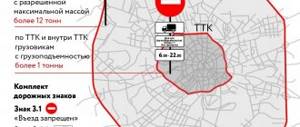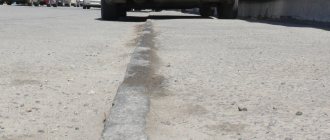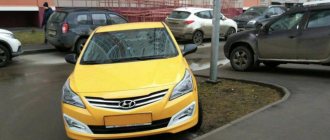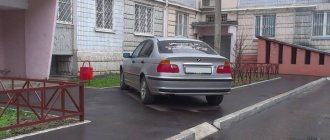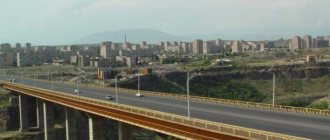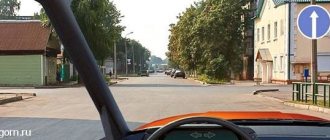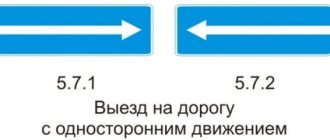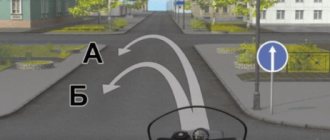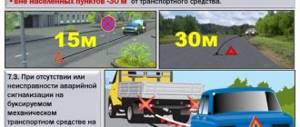Is there a fine for driving on the sidewalk?
According to the traffic rules, driving on sidewalks is subject to a mandatory fine.
A sidewalk is usually understood as a section of road designated for the movement of pedestrians. The pedestrian path is separated from the roadway by curbs, green corners and other fences. The main reasons for such offenses include:
- The roadway is congested during peak hours, causing traffic jams. Because of this, drivers are forced to constantly stand in traffic jams for a long time, which makes them nervous. Because of this, they go onto the pedestrian path.
- The desire to find a parking space near an office or residential building. Often in such places there is no parking or parking, so you have to park your car on the pedestrian path.
- The markings between the road and the sidewalk could be so erased that the driver did not notice them. This often happens in small towns, villages, and outside the city limits.
Driving a vehicle on pedestrian, bicycle paths and sidewalks is strictly prohibited. This is clearly stated in the Traffic Rules, so if the driver is stopped by traffic police officers, then you should expect trouble for entering a pedestrian area.
In this case, you will have to pay a fine. Sometimes traffic police inspectors do not have time to stop the reckless driver, but this does not mean that punishment was avoided. Photo and video cameras installed in cities across the country help track offenders.
Riding on sidewalks and paths intended for cyclists and pedestrians is permitted in the following cases:
- The machine transports goods that must be unloaded at retail outlets. When there is no detour near shops or supermarkets, then the driver has the right to drive onto the sidewalk.
- The road surface is being repaired by municipal services.
- There is no other way to get to your destination.
- Ambulance drivers, firefighters, police, and utility services are allowed to enter the pedestrian path.
How to be a witness to a crime
What is the fine for driving on the side of the road in 2021
Norm of the Code of Administrative Offenses Violation Punishment Part 1 of Art. 12.29 Violation of traffic rules by a pedestrian or passenger Warning or 500 rubles. Part 2 Art. 12.29 By cyclist or carrier 800 rubles. Part 3 Art. 12.29 Violation under Part 2 of Art. 12.
29 in a state of intoxication 1 thousand rubles. — 1,500 rub. Part 1 Art. 12.30 Violation of traffic rules by a pedestrian or passenger, which interfered with the movement of a vehicle 1 thousand rubles. Part 2 Art. 12.30 Violation under Part 1 of Art. 12.30 with minor or moderate harm to the victim’s health 1 thousand rubles. — 1,500 rub.
There are many situations when a motorist needs to drive onto the sidewalk, and in addition to overtaking a traffic jam, the driver may need to drive to a place where the car can be parked, but cannot get to this place without violating the rules.
For example, a driver would like to park his car near a store, but there is a high curb in front of the parking lot. Somewhere nearby, the height of the curb allows a car to drive in, but you will have to drive a few meters along the pedestrian path. Of course, a decent inspector will not fine you for such a violation.
If a fine is nevertheless issued, and the driver categorically disagrees with it, there is always the opportunity to appeal such a decision of the traffic police inspector. This must be done within 10 days from the date of receipt of the fine. You can file a complaint with the traffic police or the district court at the place of the incident.
Punishments
Is driving on the sidewalk a fine or another punishment? Let's figure it out.
First , let's start with the amount of the collection itself. By the way, it is the same in all regions and its amount does not change depending on who committed the violation.
So, the fine for driving on the sidewalk in a car is two thousand rubles . Agree, the amount is decent. Especially if you did not have time to pay this amount with a 50% discount on the government services website.
This measure was taken in connection with the increasing number of cases of collisions with pedestrians, as well as due to the fact that human rights activists actively insisted that the punishment be made more severe .
Many people may have heard about the so-called “Stop Ham” movement. Traffic participants fight against those who like to “move” pedestrians by sticking huge stickers on their windows, which not only block the entire view, but are also difficult to wipe off.
But what to do in a situation where it is impossible not to drive onto the sidewalk? If there was a forced movement on the sidewalk, will you still have to pay a fine? We will look at this issue in more detail in the next chapter.
Fighters for order insistently demand that drivers be punished not only with a fine, but also with the deprivation of their license. This proposal is currently under consideration.
Remember that if you witness rudeness on the part of a driver who allowed himself to drive in an area intended for pedestrians, you can file a complaint with the traffic police.
It will be good if you provide evidence in the form of a photo or video recording, as well as the license plate number and make of the vehicle. In this case, the offender will be identified from the database , or stopped at a traffic police post, where he will be charged.
Definition of a sidewalk and its difference from other elements of the road, curb, pedestrian path
Fine for driving without a license after deprivation
The importance of a clear understanding of what a sidewalk is is related to this. Wrong parking, driving in the wrong place are eternal themes in the struggle between pedestrians and drivers, on the one hand, and the same drivers and traffic police authorities, on the other hand.
It is not always possible to determine, given the circumstances, whether a particular section of the road is a sidewalk. In addition, sometimes drivers are forced to drive along the sidewalk to approach a particular object. The only worthy argument in conflict situations is impeccable knowledge of traffic rules.
What is a sidewalk
So, the definition of a sidewalk is proposed by the Traffic Rules, approved by Decree of the Government of the Russian Federation of October 23, 1993 N 1090.
A sidewalk is a part of a road that is used for pedestrian movement. This element must be adjacent to the roadway (or, alternatively, a bicycle path) or separated by an area covered with vegetation.
The sidewalk is adjacent to the roadway
It turns out that when determining the part of the road that is a sidewalk, two criteria must be present:
- The purpose of the sidewalk is for the movement of pedestrians. In exceptional cases, movement and stopping of vehicles is allowed, which will be discussed later in the article;
- design. According to this criterion, options are allowed. The sidewalk can either be adjacent to the part where vehicles travel, or be separated from it by an area with vegetation.
Differences from curb and footpath
The shoulder is understood as a part of the road adjacent to the roadway at one level, used for movement, as well as parking or stopping vehicles. The roadside differs from the part where cars drive by the type of surface or is separated by marking 1.2, which is represented by a continuous white line.
The roadside on both sides is marked with 1.2 markings
Based on the definitions, we can conclude the differences between the parts of the road under consideration:
Table: differences between sidewalk and curb
It would seem that the definitions and differences have been formulated and clarity has been introduced. However, there are difficulties in delimiting these zones due to the partial intersection of the designated features. So, for example, the side of the road is used for moving or stopping (parking a car). As for the sidewalk, these actions are also allowed on it in exceptional cases.
Paying attention to the design, we can note another similar feature - adherence to the roadway. The following feature is considered decisive: the shoulder is adjacent at the same level to the part for car traffic
This means that there are no obstacles between them and there is no difference in height.
Letter-eaters may object, because in the definition of a sidewalk there is nowhere a mandatory sign of the presence of such a division or level that differs from the roadway. Everything is clear, if there is a lawn, it is not difficult to determine the sidewalk. What if the sidewalk is adjacent to the road?
There is an area with vegetation between the sidewalk and the lawn
Here we should be guided by established practice and standards of improvement and construction of highways. Most of them indicate that in the absence of a lawn, the sidewalk should be separated from the roadway by some kind of fencing (curb, metal structure).
In this option, the sidewalk is separated by metal fences
A concept close in meaning to a sidewalk is a pedestrian path. The rules say nothing about its placement relative to the roadway. Its only direct purpose, as well as the sidewalk, is the movement of pedestrians. But, unlike a sidewalk, a pedestrian path can be located away from the roadway.
The pedestrian path is located away from the roadway
Another mandatory distinctive feature is the presence of sign 4.5.1.
Sign 4.5.1 informs about the beginning of the pedestrian path
What is the driver's responsibility for driving and parking in a pedestrian zone?
For driving and parking a vehicle in a pedestrian zone, liability is established in the form of a warning or an administrative fine.
A pedestrian zone is an area intended for pedestrian traffic, which is marked with signs:
• 5.33 “Pedestrian zone”;
• 5.34 “End of the pedestrian zone.”
Signs 5.33 and 5.34 are used to designate the territory (section of the road), the end of the territory (section of the road) on which the movement of pedestrians and cyclists is permitted in cases established by traffic regulations (clause 1.2 of the Road Traffic Regulations, approved by Decree of the Government of the Russian Federation dated October 23. 1993 No. 1090
(hereinafter referred to as
traffic rules
);
clauses 5.6.41, 5.6.44 GOST R 52289-2019, approved.
Order of Rosstandart dated December 20, 2019 No. 1425-st ).
The “Pedestrian zone” sign can be used with additional information signs (plates) indicating that the pedestrian zone is valid only at certain times, for example with the sign 8.5.1 “Saturdays, Sundays and holidays” or 8.5.5 “Validity hours” (p. 8 Appendix 1 to the traffic rules
).
The pedestrian zone should be distinguished from the residential zone, which is indicated by signs 5.21 and 5.22. In residential areas, pedestrians have the right of way, but they must not unreasonably interfere with vehicular traffic. The movement of pedestrians in a residential area is permitted both on sidewalks and on the roadway, and the movement and parking of vehicles is permitted with a number of exceptions (clauses 17.1, 17.2 of the Traffic Regulations
).
It should be taken into account that there are also pedestrian paths - strips of land or surfaces of an artificial structure equipped or adapted for pedestrian movement. They are indicated by sign 4.5.1 and are used for the movement of pedestrians and cyclists in cases established by traffic regulations. The movement of vehicles on pedestrian paths is prohibited (clauses 1.2, 9.9 of traffic rules
;
clause 5.5.9 GOST R 52289-2019
).
The movement of any vehicles is prohibited in the pedestrian zone. Cyclists under the age of 14 can move within pedestrian zones (clauses 24.3, 24.4 of traffic rules
).
A driver who drives a vehicle into a pedestrian zone may be held accountable in the form of a warning or an administrative fine of 500 rubles. (Part 1 of Article 12.16 of the Code of Administrative Offenses of the Russian Federation
).
Stopping or parking a vehicle in a pedestrian zone entails a warning or the imposition of an administrative fine in the amount of 500 rubles, and if this violation is committed on the territory of the city. Moscow or St. Petersburg, the punishment includes the imposition of an administrative fine in the amount of 2,500 rubles. (part 1, 5 of article 12.19 of the Code of Administrative Offenses of the Russian Federation
).
As a general rule, an administrative fine must be paid in full no later than 60 days from the date the resolution in the case of an administrative offense comes into force (Part 1 of Article 32.2 of the Code of Administrative Offenses of the Russian Federation
).
If a fine is paid for an offense no later than 20 days from the date of the decision to impose it, the amount of the fine is reduced by 50%. If the execution of the decision was delayed or spread out, the fine is paid in full (Part 1.3 of Article 32.2 of the Code of Administrative Offenses of the Russian Federation
).
In Moscow, you can obtain information about existing fines, in particular, through the system of interactive interaction with citizens and organizations “Autocode” (clauses 1.3, 1.4.2 of the Regulations, approved by Resolution of the Moscow Government dated October 25, 2016 No. 700-PP
).
Based on materials (“Electronic magazine “ABC of Law”, 2020)
Riding on the sidewalk article koap
Fine for tinting in 2019
Formal inaccuracies in procedural documents can also play in the driver’s favor.
The decision must be contested within 10 days by sending a corresponding complaint to the court or directly to the traffic police. The complaint must describe in detail the circumstances of the case, indicate the offense for which the driver was held accountable, substantiate his position of innocence and confirm this with facts following from the attached documents (photos, videos, explanations of witnesses).
Nanofilm invisible to cameras for license plates
Fines for crossing the stop line and speeding will no longer bother you!
The response time depends on the authority where the complaint is filed. The court can consider the case within two months, and the body whose official made the decision - within 10 days.
To avoid troubles associated with paying administrative fines and the need to appeal them, drivers should be guided by the general requirement to prohibit driving or stopping on the sidewalk.
Is it possible to appeal a fine for driving on the sidewalk?
If you disagree with prosecution, you should not consider the issuance of a decision by a traffic police officer for driving or parking on the sidewalk as a final decision on a controversial issue.
Drivers often disagree with the conclusions of the traffic police in the following possible situations:
- there is a dispute about whether the section of road on which the parking is located is a sidewalk or another element of the road (for example, a shoulder). This happens in the absence of obvious signs of one or another element of the road. In this case, the driver can be helped by an impeccable knowledge of terms and the ability to justify his position;
- travel was carried out along the sidewalk to the store for the purpose of unloading, but the very fact of unloading is not obvious and requires additional research.
We do not recommend ignoring the resolution for reasons of disagreement with it, since if the fine is not paid within 70 days, additional sanctions will follow.
To have a reasoned appeal against a decision to impose a fine, the driver needs to record the circumstances of the case - take a photo or video, find witnesses, and support his arguments with the rules of the Traffic Regulations and the Code of Administrative Offenses.
If a violation is recorded on the spot and the driver disputes the fact of the violation, then the traffic police officer is obliged, in addition to the decision, to also draw up a protocol. The driver should carefully study the document and indicate his disagreement in it. Formal inaccuracies in procedural documents can also play in the driver’s favor.
The decision must be contested within 10 days by sending a corresponding complaint to the court or directly to the traffic police. The complaint must describe in detail the circumstances of the case, indicate the offense for which the driver was held accountable, substantiate his position of innocence and confirm this with facts following from the attached documents (photos, videos, explanations of witnesses).
The response time depends on the authority where the complaint is filed. The court can consider the case within two months, and the body whose official made the decision - within 10 days.
To avoid troubles associated with paying administrative fines and the need to appeal them, drivers should be guided by the general requirement to prohibit driving or stopping on the sidewalk. If you cannot do without driving onto the sidewalk, make sure that such a need is provided for by the traffic rules and at the same time you guarantee the safety of citizens.
Driving on the sidewalk is a fine
Important
Failure to comply with the requirements of signs prohibiting the movement of vehicles whose weight or load exceeds the value indicated on the sign, without special notice. permissions 5 thousand
rub. Part 1 Art. 12.21.2 Transportation of dangerous cargo without certificates of admission of the driver and vehicle for transportation, special permit or emergency card, in case of non-compliance with the design of the vehicle or lack of information about the danger of the cargo, equipment for eliminating the consequences of the incident, non-compliance with the conditions for the transportation of dangerous goods. FL - 2 thousand rubles . — 2,500 rub. or LP for 4 months. — 6 months DL - 15 thousand rubles. — 20 thousand rubles. Legal entity - 400 thousand rubles. — 500 thousand rubles. Part 2 Art. 12.21.2 Other violations except Part 1 of Art. 12.21.2 FL - 1 thousand rubles. — 1,500 rub. DL - 5 thousand rubles. — 10 thousand rubles. Legal entity - 150 thousand rubles. - 250 thousand
Movement of a vehicle (weighing more than 12 tons) on public roads without a fee, if it is obligatory - 5 thousand rubles. Part 2 Art. 12.21.3 Repeated violation under Part 1 of Art. 12.21.3 10 thousand rubles. Art. 12.22 Violation of the rules of training driving by an instructor Warning or fine 500 rubles. Part 1 Art. 12.23 Violation of the rules for transporting people 500 rubles. Part 2 Art. 12.23 Transportation of people outside the cabin of a vehicle, tractor, on a cargo trailer, caravan trailer, in the back of a cargo motorcycle or outside seating areas 1 thousand rubles. Part 4 Art. 12.23 Transportation of children by buses or by a driver who does not meet the requirements of PP No. 1177, without an insurance contract, route program, list of children and accompanying individuals - 3 thousand rubles. DL - 25 thousand rubles. Legal entity - 100 thousand rubles. Part 5 Art. 12.23 Violation of the rules for transporting children at night FL - 5 thousand rubles. or LP for 4 months. — 6 months DL - 50 thousand rubles. Legal entity - 200 thousand rubles. part 6 art. 12.23 Other violations of the rules for transporting children
DL - 25 thousand.
Legal entity - 100 thousand rubles.
Part 1 Art. 12.28 Violation of vehicle traffic rules in residential areas RUB 1,500. Part 2 Art. 12.28 Violation under Part 1 of Art. 12.28 in Moscow and St. Petersburg 3 thousand rubles. Part 1 Art. The traffic police fines table 2021 with punishment for traffic violations is divided into thematic blocks. For work, consider the meanings of abbreviations:
- TS is a vehicle.
- LP - deprivation of rights.
- FL is an individual.
- DL - official.
- LE is a legal entity.
- IP is an individual entrepreneur.
- Violations with punishment in the form of deprivation of rights are highlighted in yellow.
- Green - with administrative arrest.
I advise you to print out the table and put it in your car so that you can always be on guard if troubles arise on the road:
Full table of traffic police fines in 2021 (PDF, 208 KB)
Note! In 2021, there are no new traffic police fines in the Code of Administrative Offenses, so this table is current and compiled taking into account the latest changes in the law
What is the fine?
15 of the Russian Code of Administrative Offenses). The fine will be 2 times less if the motorist parks on a pedestrian path. Stopping a car on the sidewalk is considered even if the driver drives into a prohibited area with one wheel.
This applies to both borders and green spaces. If a driver parks his car near his home or office in this way, then he can only pick up his vehicle from the impound lot after paying fines.
Driving on the side of the road is also an offense and is punishable by a fine of 500 rubles. In cities such as St. Petersburg, Moscow, as well as settlements of federal significance, driving a car on the sidewalk will cost 3 thousand rubles.
After issuing a fine, drivers have the right to appeal the notification received in court. According to the law, only 10 days are allotted for this. During this time, the driver has the right to write a complaint to the traffic police against the inspector who issued the notice, or to file an application directly to the court.
The case before the court may drag on for several weeks or months. The court decision must be complied with within 60 days. Otherwise, the bailiffs will collect the fine. If the court rules that the driver is not guilty, then the penalties will be canceled.
Fines for driving on the sidewalk for cars and bicycles in 2021
Driving a car on the sidewalk is considered a serious violation of traffic rules, as this can result in a collision with a pedestrian. What does a driver face for such actions, and what is the fine for driving on the sidewalk in 2021? What other measures are taken against the driver for this violation?
In what cases is driving allowed?
A fine for driving or parking in a pedestrian zone is not always issued. Sometimes it is allowed to park vehicles on the edge of the sidewalk. You can park your car if there is a sign permitting parking and a sign indicating the position of the vehicle in relation to the sidewalk. In other cases, the violator faces a fine for parking in the wrong place.
Sometimes, in an organized parking area, the dividing curb is too high and because of this it turns out to be insurmountable for cars with low clearance. In such circumstances, car owners drive onto the sidewalk in another place where a lower curb is installed, and then move along the sidewalk to the parking area.
In these areas, traffic police officers are loyal to driving on the sidewalk and do not impose sanctions.
Are vehicles allowed on sidewalks or walkways in other circumstances? Indeed, traffic police inspectors should not impose sanctions on drivers who drive onto the sidewalk for the following purposes:
- unload goods at the point of sale;
- get to your own home.
Thus, for those entrepreneurs who do not know whether it is possible to drive onto the sidewalk to unload goods into a store, the answer is definitely positive. If a driver entered a pedestrian zone for one of the reasons listed above, and was stopped by a traffic police officer, you just need to clarify the situation. If the inspector nevertheless issues a fine, this is unlawful, such actions of a representative of a law enforcement agency can be challenged. Special equipment of municipal and road services is also not prohibited from moving through the pedestrian zone.
Riding a bicycle on the sidewalk is also not prohibited; if there is no bicycle lane on the road, it is impossible for a cyclist to ride on the right side of the roadway or on the side of the road. But if, when riding on a pedestrian path, a cyclist interferes with persons traveling on foot, he must dismount and continue moving as a pedestrian.
Fine for driving on a pedestrian path
Crime statistics show that drivers most often drive on the sidewalk when trying to avoid traffic congestion. The punishment for driving on the sidewalk usually involves monetary penalties. Rule violators, before committing an illegal act, should know what fine the traffic police inspectors can impose for driving on the sidewalk in 2019. According to the Administrative Code, the fine is 2 thousand rubles.
If a car owner parks a vehicle on the sidewalk, this is also punishable by law. The violator is fined for parking on the sidewalk; its amount is 1.5 thousand rubles. For the same violation, but in Moscow and St. Petersburg, the driver will lose 3 thousand rubles in the form of a fine.
Often in a metropolis, when there is a catastrophic shortage of parking, drivers drive onto the lawn for the purpose of parking. A lawn is an area of territory on which there is grass cover, created naturally or artificially. It is prohibited to park vehicles in such areas; this situation is recorded in the traffic rules. The violator pays a fine for parking on the lawn, it is 1.
5 thousand rubles. If a driver drives onto a lawn in the capital or St. Petersburg, monetary sanctions are doubled.
As mentioned earlier, riding a bicycle on the sidewalk is only allowed in certain cases. The fine for riding a bicycle on the sidewalk is 800 rubles. But practice shows that cyclists are rarely fined for such actions. Traffic police inspectors are extremely loyal to cyclists riding on the sidewalk.
Read also: How long do you need to drive with the “Beginner Driver” sign?
Any protocol on the imposition of a fine can be appealed. This can be done by writing a complaint to the traffic police or filing a statement of claim in court. You can appeal an unfair punishment within 10 days from the date of registration of the protocol.
Who is the sidewalk intended for and what is written about it in the traffic regulations?
The Traffic Rules designate the sidewalk as an element of the road surface, on which movement is permitted only on foot. As a rule, the pedestrian part of the road is separated from the car lanes by a lawn or curb. Curbs and lawns are designed to restrict vehicle traffic.
There is another type of path designed only for pedestrians - a pedestrian path. Unlike sidewalks, paths are located near the highway or at a significant distance from it (for example, in parks or squares). To indicate pedestrian travel routes, a special road sign has been developed (clause 4.5.1), which, according to general rules, is valid until the nearest intersection.
Drivers often violate traffic rules because they do not notice the differences between the curb and the sidewalk.
Features of the shoulder, as an element of the road, are as follows:
- Has different coating and markings.
- Located at the level of the roadway.
- Adjacent to the road surface.
- Not used for walking.
To the question: is it allowed to drive cars on sidewalks (or pedestrian paths), the Traffic Rules give a positive answer in the following situations:
- for special equipment vehicles (for example, emergency services);
- for a personal vehicle, if there is no other way to drive up to the house parking lot;
- for unloading goods into the store (loading for delivery to the buyer).
The legislator categorically prohibits the placement of vehicles on sidewalks, regardless of the time of stop. Traffic on the sidewalk is also not allowed under traffic regulations.
Places to stop
When operating a car, it is worth distinguishing between concepts such as parking and stopping. The difference between them is the time that the car can stand without moving - after 5 minutes the stop becomes a parking lot.
When a violation is detected, traffic police officers observe the driver’s behavior - if he does not remove his vehicle from a prohibited place within 5 minutes, this becomes the basis for imposing a fine. Recording of events and time usually occurs using special technical means that have been appropriately tested and can be used for such purposes.
For late payment of a fine, additional punishment is imposed (Part 1 of Article 20.25 of the Code of Administrative Offenses):
- another fine in double the amount of the unpaid amount;
- compulsory work lasting up to 50 hours;
- administrative arrest for up to 15 days.
In addition, as of July this year, a new sign 8.9.1 was introduced, which indicates parking spaces intended only for drivers with special permits. Such permission is issued by executive authorities and is valid in the territory of the region where it was received.
When parking and parking on the sidewalk are permitted according to the rules
The problem of parking and stopping places for car owners is acute. Vehicle owners are sometimes forced to park in the wrong place. This problem is especially noticeable in large cities, when almost every resident has a vehicle.
Road services solve this problem and allocate parking areas near sidewalks. The car owner will know whether parking on the sidewalk is allowed in a particular place in the city by sign 6.4 - parking. There may be information signs underneath that will tell you how to park.
Motorcycles and cars can be parked near sidewalks in the following way:
- parallel to the carriageway with full access to the sidewalk territory;
- with permission to drive only front or rear wheels;
- parallel to the curb or sidewalk edge;
- driving with either the right or left wheels of the vehicle;
- full parking with the condition that the front/rear part of the vehicle faces the roadway.
Information signs are designed in such a way that any car owner will understand the parking rules. Such signs must be placed together with a blue parking sign on the sidewalk.
Sidewalk in traffic rules
Traffic and parking of vehicles is prohibited on the side of the road, but is permitted in a special area near the sidewalk. Using the road surface for people will result in a fine and evacuation of the violator's car.
Expert opinion
Artemyev Dmitry
Experience as a forensic expert in the field of automotive technical examination for more than 2 years, more than 3 years of work in the field of insurance disputes, appealing guilt in road accidents.
Ask a Question
The law distinguishes between the concepts of sidewalk, curb, pedestrian path and sidewalk parking. The shoulder is connected to the roadway and is at the same height as the road. The area can be separated by a marking line or type of coating.
The sidewalk is adjacent to the road, separated by a green lawn or curb, and is intended for pedestrians.
There are no problems with the separator. It is difficult to determine the intended purpose of the adjacent area without markings: there is no sign on it. Often this is the side of the road on the highway, but in the city it is the sidewalk.
Advice! It is better to consider an unidentified type of roadway adjacent to the roadway as a sidewalk and not drive onto it.
Parking lots near sidewalks are permitted for use by motorists and are marked with road signs that depict the legal position of the vehicle:
The radius of the sign is not determined. Typically, such areas are limited by a curb, which cannot be driven onto unless permitted by a picture on a table showing the position of the car in relation to the sidewalk.
The pedestrian path is intended for people and cyclists. As a rule, a section of a path is limited by two duplicate signs for the beginning and end of a given section. Driving on footpaths is prohibited and punishable.
From the video you will find out what fine a driver faces for parking on the sidewalk:
Fines for parking on the sidewalk
You cannot park on the sidewalk. But for a certain category of vehicles, exceptions are made in areas where there are sidewalk parking areas indicated by appropriate signs. This relaxation is possible only for cars, motorcycles, mopeds and bicycles.
Be careful! A rectangular sign under the sign must indicate the conditions for partial entry onto the sidewalk - for example, it is allowed to do this with two or four, left or right wheels, and so on.
Even if there is a sign permitting parking, but non-compliance with its conditions, the driver, according to the law, faces a full fine - a thousand rubles. It’s better not to take risks and not park if there is no warning sign. As in the case of driving on the sidewalk, penalties increase in capitals and other cities with large populations, reaching three thousand or more rubles. But that's not all.
An incorrectly parked vehicle with an absent driver may be redirected to a penalty area. In this case, the owner’s wallet will be lightened by approximately another five thousand - this is how much the services for evacuation and storage of movable property will cost. If the driver is nearby and manages to quickly eliminate the violation, he will only get off with a fine.
Responsibility for violation
Article 12 of the Code of Administrative Offenses establishes a fine for driving on the sidewalk. A violation is classified as driving over a curb that limits a part of the street for people, or hitting it with one wheel of a car. For the initial violation, the driver will have to pay two thousand rubles.
Stopping or parking a vehicle in a prohibited area is the basis for a protocol of 1000 rubles.
Interesting! For the capital cities of Moscow and St. Petersburg, the fine for parking on the sidewalk is higher - 3,000 rubles.
For parking on the boulevard, the driver faces not only an administrative penalty, but also the evacuation of the car to a special parking lot.
Representatives of the Public Chamber of the Russian Federation propose to tighten the punishment to deprivation of a driver's license for repeated driving on the sidewalk, but the law on this has not yet been adopted.
Driving on the sidewalk fine 2021
Failure to comply with road safety requirements during the repair and maintenance of roads, railway crossings or other road structures, or failure to take measures to promptly eliminate obstacles to traffic, prohibit or restrict road traffic on certain sections of roads if the use of such sections threatens road safety fine: for officials from 2000 to 3000 rubles, for legal entities 300,000 rubles. 12.35 Application to owners and drivers of vehicles and other road users of measures not provided for by federal law aimed at restricting the rights to drive, use or operate a vehicle: fine: for citizens 2,000 rubles, for officials 20,000 rubles. 12.361 Use of a telephone by a driver while driving a vehicle that is not equipped with a technical device that allows hands-free negotiations, a fine of 1,500 rubles. 12.37 part 1 Driving a vehicle during the period of its use, not provided for by the insurance policy of compulsory insurance of civil liability of vehicle owners, as well as driving a vehicle in violation of the conditions stipulated by this insurance policy for driving this vehicle only by the drivers specified in this insurance policy, a fine of 500 rubles. 12.37 part 2 Failure by the owner of the vehicle to fulfill the obligation established by federal law to insure his civil liability, as well as driving the vehicle, if such compulsory insurance is obviously absent. Details about fines for lack of MTPL insurance. fine 800 rub. 19.3 part 1 Disobedience to a lawful order or requirement of a police officer, military personnel or employee of a body or institution of the penal system in connection with the performance of their duties to protect public order and ensure public safety, as well as obstruction of their performance of official duties - a fine of 500 to 1000 rubles . or arrest for up to 15 days 19.22 hours. Release on the line of a vehicle that has faults with which operation is prohibited, or converted without the appropriate permit; a fine for officials from 5,000 to 8,000 rubles. 12.31 part 3 Release onto the line of a vehicle with obviously false state registration plates or with lighting devices installed on its front part with red lights or red reflective devices, as well as lighting devices, the color and mode of operation of which do not comply with the requirements of the Basic Provisions for Admission Vehicle operation and duties of officials to ensure road safety; fine for officials from 15,000 to 20,000 rubles, for legal entities - 50,000 rubles. 12.31 part 4 Release onto the line of a vehicle with devices installed on it without appropriate permission for sending special light or sound signals (with the exception of security alarms), as well as with special color graphics of emergency service vehicles illegally applied to its outer surfaces fine for officials 20,000 rub., for legal entities - 50,000 rub. 12.32 Admission to drive a vehicle by a driver who is intoxicated or does not have the right to drive a vehicle; fine for officials is 20,000 rubles. 12.33 Damage to roads, railway crossings or other road structures or technical means of organizing traffic, which poses a threat to road safety, as well as intentional interference with road traffic, including by polluting the road surface fine: for citizens from 5,000 rubles. up to 10,000 rubles, for officials 25,000 rubles, for legal entities 300,000 rubles.
The traffic rules will legalize driving on sidewalks and reduce the number of parking spaces in cities
Collage: Legal.Report The Ministry of Transport of Russia has prepared extensive amendments to the traffic rules, according to which the owners of electric scooters, hoverboards, motor wheels, Segways, etc. will become separate road users. Requirements are established not only for the persons operating such devices, but also for the equipment itself. In addition, the ministry proposes to change and supplement some points of the traffic rules related to parking and stopping transport. In particular, the responsibility for stopping at traffic islands is being sharply tightened.
Owners of electric scooters are limited in speed and prescribed sobriety
The current traffic rules, as stated in the explanatory note to the document, consider pedestrians to be persons “who use roller skates, scooters and other similar means for transportation.” Meanwhile, recent technology (for example, electric scooters) can reach speeds of up to 80 km/h, which poses a mortal danger to people walking on sidewalks. The responsibility of persons operating such equipment is very vague.
To rectify the situation, the Ministry of Transport proposes:
— introduce a new term and its definition into the traffic rules: “Individual mobility device” - a device intended for the movement of a person through the use of an electric motor (electric motors) and (or) human muscular energy (roller skates, scooters, electric scooters, skateboards, electric skateboards, hoverboards, Segways , unicycles and other similar means);
- introduce a new road user into the traffic rules - a person using a personal mobility device for transportation;
— introduce a ban on the use of bicycles and personal mobility devices for movement in pedestrian areas (except for children under 7 years of age);
— establish the priority (priority) of pedestrians in all cases of combined traffic with cyclists and persons using personal mobility devices (hereinafter referred to as SIM) for movement. Thus, if the movement of a cyclist or a person using a SIM for movement on a sidewalk, pedestrian path or shoulder endangers or interferes with the movement of pedestrians, the person operating this equipment must dismount. Or reduce your speed to a speed not exceeding the speed of pedestrians;
- in all cases of combined traffic with pedestrians, set the maximum speed of cyclists and people using SIM cards for movement - 20 km/h;
- ride bicycles and SIM only on sidewalks, pedestrian and bicycle paths (on the side of pedestrian traffic), pedestrian zones;
— establish that persons aged 7 to 14 years using a SIM card for transportation must move on sidewalks, pedestrian, bicycle and pedestrian paths (on the side for cyclists). Children under 7 years old can also ride in pedestrian areas;
— establish that persons over 14 years of age who use SIM cards for transportation must move along bicycle lanes, bicycle and bicycle pedestrian paths, and the roadway of bicycle zones.
In the absence of the specified infrastructure, they can drive on sidewalks and pedestrian paths, and in the absence of such, they are allowed to drive on the side of roads. Driving on the right edge of the carriageway is permitted only on roads with a maximum speed limit of 60 km/h and for SIM cards that meet certain technical requirements. In particular, it must be equipped with an electric motor, a brake, a sound signal, white reflectors in the front, orange or red on the sides, red in the rear, a white headlight (lantern) in the front, which in the dark or in conditions of poor visibility should be included;
— prohibit driving on the right edge of the roadway on a SIM with gyroscopic stabilization (except for bicycle zones);
— set the maximum speed of the SIM to no more than 20 km/h in residential areas, bicycle areas and courtyard areas;
— prohibit the use of SIM for movement by a person who is intoxicated (alcohol, drugs or other), under the influence of medications that impair reaction and attention, in a painful or tired state;
— introduce a new road sign 3.35 “Movement of persons on personal mobility devices is prohibited” and new road signs (plates) 8.27 “Persons on personal mobility devices”, 8.28 “Except for persons on personal mobility devices”.
A “pedestrian” in the updated traffic regulations will be a person who is outside a vehicle on the road or on a pedestrian or bicycle path and does not work on them. Persons moving in wheelchairs, driving (driving, carrying) a personal mobility device, bicycle, moped, motorcycle, sled, cart, child stroller or wheelchair are considered pedestrians.
The authors of the amendments assure that the best global experience was taken into account when developing them. For example, France is also introducing a new category of vehicles - “motorized personal vehicle”. According to this document, the driver’s age must be at least 12 years. Driving such vehicles using an engine on the sidewalk will be prohibited (except when permitted by the head of the urban settlement). In cities, traffic must use bicycle paths and bicycle lanes; in the absence of which, traffic on roads with a speed limit of no more than 50 km/h is permitted. The maximum speed is set at 20 km/h, and on roads with active pedestrian traffic - 8 km/h. The use of scooters whose maximum speed exceeds 25 km/h is generally prohibited.
The speed limit of 20 km/h for such vehicles is also in effect in the USA, Sweden and Germany. In some countries, driving on sidewalks is prohibited altogether.
Huge fine instead of a concrete flowerbed
Another block of amendments to the traffic rules proposed by the Ministry of Transport is related to parking and stopping vehicles and a number of other issues.
“Taking into account incoming requests from citizens and organizations, as well as judicial practice, in order to eliminate discrepancies in traffic rules requirements,” the actions of road sign 3.27 “Stopping is prohibited” have been adjusted. It will be possible to reduce its coverage area by installing signs 5.29 “Regulated parking zone” and 6.4 “Parking”.
For signs 3.29 “Parking is prohibited on odd days of the month” and 3.30 “Parking is prohibited on even days of the month,” it is planned to shift the time interval for rearranging vehicles: instead of 19:00–21:00, it will be set to 21:00–00:00.
Other changes are related to the preparation of the draft national standard GOST R 52289 “Technical means of organizing road traffic. Rules for the use of road signs, markings, traffic lights, road barriers and guide devices.” Based on it, new road signs and markings are introduced into the traffic rules.
In particular, road signs 6.4 “Parking (parking space)” can be combined with signs 8.8 “Paid. This proposal from the Ministry of Transport is based on the results of an experiment that was conducted in 2021 in Moscow, St. Petersburg, Vladimir and Saratov regions. Combining signs allows you to significantly reduce the number of road signs on the road network without affecting their perception by road users.
Image: government.ru
To inform drivers about places to charge electric vehicles, a new sign (plate) 8.26 “Charging electric vehicles” will appear at service facilities.
Taking into account the practice of restricting the movement of buses in the territories of the cities that hosted the 2018 FIFA World Cup, road sign 3.34 “Bus traffic is prohibited” is being introduced, which does not prohibit the movement of route vehicles and school buses.
In addition, the draft resolution introduces a new type of road marking 1.14.3 to indicate a diagonal pedestrian crossing, which is similar in appearance to marking 1.7, and its dimensions are similar to marking 1.14.1.
In order to improve and optimize the parking space, it is planned to use markings 1.7 to designate the parking area, including without dividing it into parking spaces. To visually separate paid and free parking zones, it is planned to use blue and white markings, respectively. This, as the ministry emphasizes, does not contradict the Vienna Convention on Road Signs and Signals of 1968.
And finally, the Ministry of Transport proposes to strengthen the fight against parking on traffic islands and traffic islands. Now, to eliminate such parking and ensure visibility in such places, “small architectural forms or concrete blocks that are not intended for this purpose are often installed, worsening not only the appearance of the city, but also reducing road safety, especially at night and in winter.” Now it is proposed to extend clause 12.4 to cases of such parking. Traffic rules “Stopping is prohibited” with corresponding sanctions.
